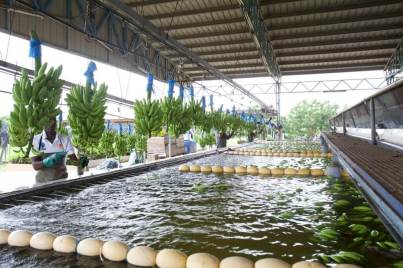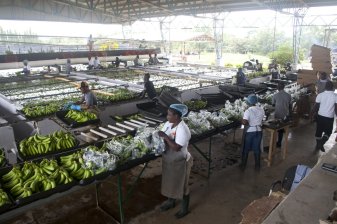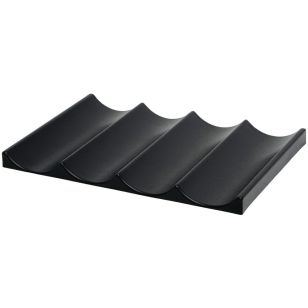Ship, Ripen, Store and Distribute All In One Intermodal Container

The animated video above shows platforms suspended from crossbars that are rotating on a carousel. The ends of the crossbars have rollers attached to ride inside a C-channel and function much like the rollers on a garage door, travelling the length of the carousel similar to the systems that many dry cleaners use. These platforms replace wooden pallets and we added side panels to the platforms to create cubic “modules” that protect their contents much better than pallets wrapped in plastic film.
The following video gives a more detailed description of the system’s functionality.
We chose the banana supply chain as our first business use case so we focus on banana shipping with the Cargo Carousel System (CCS) and, as compiled by EARTH University in Costa Rica, the numbers below show that our new system can reduce single-use packaging costs by $188,000,000 annually in Costa Rica’s banana sector alone.
Packaging Cost Reductions in the Costa Rica Banana Sector

How It Works
 Freshly harvested green bananas are brought from the field to the packing house as large bunches that are suspended on long conveyor lines to ease the manual burden. Once at the packing house the bunches are cut into smaller bunches of about 5 to 10 fingers, like the ones you buy in the store.
Freshly harvested green bananas are brought from the field to the packing house as large bunches that are suspended on long conveyor lines to ease the manual burden. Once at the packing house the bunches are cut into smaller bunches of about 5 to 10 fingers, like the ones you buy in the store.

These smaller bunches are then bathed in a disinfectant solution and labeled before they are put onto trays so a conveyor belt can move them to a separate area where they are put into plastic bags before being packed into cardboard boxes.

 These boxes are then positioned onto wooden pallets in such a way that they create a seven foot high structure whose outside dimensions are roughly the size of the pallet. Plastic corner straps are then put on the four corners of this structure and then wrapped together to create a more stable single structure for shipping.
These boxes are then positioned onto wooden pallets in such a way that they create a seven foot high structure whose outside dimensions are roughly the size of the pallet. Plastic corner straps are then put on the four corners of this structure and then wrapped together to create a more stable single structure for shipping.
These seven foot high structures are then loaded into an intermodal steel shipping container or “seacan” which is eight feet tall, eight feet wide and usually forty feet long. Each of these intermodal steel shipping containers are refrigerated and loaded onto ships for transport where they’re continuously monitored.
 Once they arrive at their destination port they are unloaded from the ship and placed directly on a truck for transport to a ripening facility or they are stored at the dock until a truck arrives. Many distribution centers (DC) have their own ripening facilities built-in but these take up valuable storage space and the ethylene gas that is used to ripen climacteric fruits like bananas may escape and negatively affect other produce within the DC. This is the reason that many ripening facilities are kept separate from the DC but the loading and unloading at each facility is labour intensive. Either way, the bananas have to be exposed to ethylene gas to begin the ripening process.
Once they arrive at their destination port they are unloaded from the ship and placed directly on a truck for transport to a ripening facility or they are stored at the dock until a truck arrives. Many distribution centers (DC) have their own ripening facilities built-in but these take up valuable storage space and the ethylene gas that is used to ripen climacteric fruits like bananas may escape and negatively affect other produce within the DC. This is the reason that many ripening facilities are kept separate from the DC but the loading and unloading at each facility is labour intensive. Either way, the bananas have to be exposed to ethylene gas to begin the ripening process.
 Ethylene is a flammable gas found in nature that acts as a catalyst to begin the ripening process of climacteric fruits (fruits that continue to ripen after being picked – bananas, tomatoes, avocados, etc.) and, once started, the process cannot be stopped. As soon as the ripening process begins, the bananas are loaded back onto trucks for delivery to the retailers.
Ethylene is a flammable gas found in nature that acts as a catalyst to begin the ripening process of climacteric fruits (fruits that continue to ripen after being picked – bananas, tomatoes, avocados, etc.) and, once started, the process cannot be stopped. As soon as the ripening process begins, the bananas are loaded back onto trucks for delivery to the retailers.
New Processes with the Cargo Carousel System
We’ll pick up this story back in the packing house where the bananas are being removed from the trays on the conveyor belt and being put into boxes. Instead of putting the bananas into boxes we would simply slide the entire tray that they’re already sitting on, into the four-foot cubic module because it acts as a rack with variable levels on which to slide the trays into, so space utilization within the cubic module can be maximized. The four-foot cubic modules can be divided in half to create a rack for two two-foot square trays on each side that are already being used and are much easier for humans to handle.
 Once the four-foot cubic module is full of bananas it is loaded onto an intermodal steel shipping container that contains a Cargo Carousel System. This system allows the four-foot cubic modules to move within the intermodal steel shipping container on two levels, one on top of the other, so the full eight-foot height of the container can be fully utilized. As each four-foot cubic module is removed from the Carousel, it creates space to put another module back on in its place. This allows empty four-foot cubic modules to be taken from the Carousel and brought to the area where the bananas are put into boxes but, again, instead of putting the bananas into boxes, the bananas are left on their trays and the entire tray is slid into the four-foot cubic module at variable heights of the racks as necessary.
Once the four-foot cubic module is full of bananas it is loaded onto an intermodal steel shipping container that contains a Cargo Carousel System. This system allows the four-foot cubic modules to move within the intermodal steel shipping container on two levels, one on top of the other, so the full eight-foot height of the container can be fully utilized. As each four-foot cubic module is removed from the Carousel, it creates space to put another module back on in its place. This allows empty four-foot cubic modules to be taken from the Carousel and brought to the area where the bananas are put into boxes but, again, instead of putting the bananas into boxes, the bananas are left on their trays and the entire tray is slid into the four-foot cubic module at variable heights of the racks as necessary.
When the four-foot cubic module is full of bananas it is returned to the loading dock and put back onto the Cargo Carousel System where the entire process begins again. This is continued until the entire Cargo Carousel System is full and the entire intermodal steel shipping container is then ready to be loaded onto a ship and handled just like it would be with current processes including transport to the ripening center, to the DC or to the retailer.
 Once the four-foot cubic modules are emptied they are easily cleansed for phytosanitary requirements and then available for use with any item needing transport because the trays are easily stacked at the bottom of each four-foot cubic module for further shipping requirements and not just bananas. Shipping companies spend over $20 billion annually just to re-position empty intermodal steel shipping containers for further use and all shippers pay the price for that (including the environmental price). Our four-foot cubic modules are interchangeable between Cargo Carousel Systems so many different loads within each of our four-foot cubic modules can be consolidated into a single intermodal steel shipping container to gain full load shipping rates while adding flexibility to supply and reverse chains and dramatically improving efficiency.
Once the four-foot cubic modules are emptied they are easily cleansed for phytosanitary requirements and then available for use with any item needing transport because the trays are easily stacked at the bottom of each four-foot cubic module for further shipping requirements and not just bananas. Shipping companies spend over $20 billion annually just to re-position empty intermodal steel shipping containers for further use and all shippers pay the price for that (including the environmental price). Our four-foot cubic modules are interchangeable between Cargo Carousel Systems so many different loads within each of our four-foot cubic modules can be consolidated into a single intermodal steel shipping container to gain full load shipping rates while adding flexibility to supply and reverse chains and dramatically improving efficiency.
 The cubic banana modules are made of wire-welded mesh to ensure maximum exposure to the surrounding atmosphere. This allows ethylene gas to permeate each of the bananas completely to guarantee uniform ripening. By ripening the fruit within the same container that it’s being shipped in, the labour for loading and unloading is dramatically reduced along with storage and distribution costs. Ripening in transit has been a sought after concept for many years due to its many benefits as this article from Fleet Owner magazine demonstrates but using cardboard boxes as air plenums to direct the flow of ethylene in not the answer. Carrier no longer sells their system because boxes shifted in transit and defeated the entire system and, to date, no one has come up with a solution, until now.
The cubic banana modules are made of wire-welded mesh to ensure maximum exposure to the surrounding atmosphere. This allows ethylene gas to permeate each of the bananas completely to guarantee uniform ripening. By ripening the fruit within the same container that it’s being shipped in, the labour for loading and unloading is dramatically reduced along with storage and distribution costs. Ripening in transit has been a sought after concept for many years due to its many benefits as this article from Fleet Owner magazine demonstrates but using cardboard boxes as air plenums to direct the flow of ethylene in not the answer. Carrier no longer sells their system because boxes shifted in transit and defeated the entire system and, to date, no one has come up with a solution, until now.
With a dramatic reduction in packaging and shipping costs, small farmers could split these savings with retailers to create a win-win situation in all produce chains and make the transition to this new system more attractive to both parties.